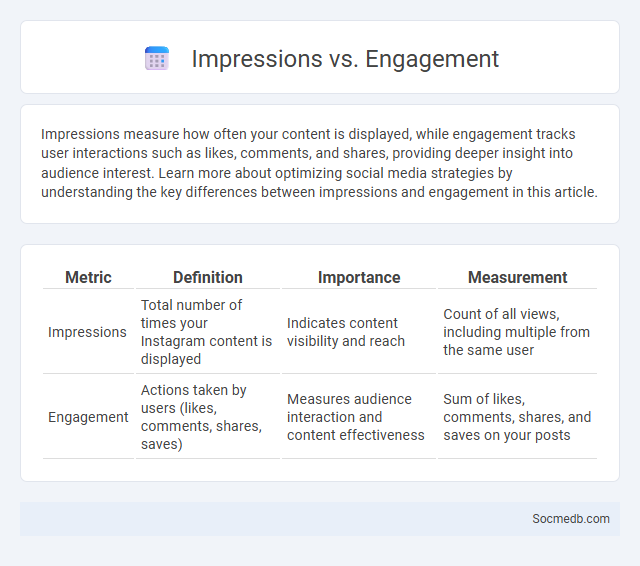
Photo illustration: Impressions vs Engagement
Impressions measure how often your content is displayed, while engagement tracks user interactions such as likes, comments, and shares, providing deeper insight into audience interest. Learn more about optimizing social media strategies by understanding the key differences between impressions and engagement in this article.
Table of Comparison
| Metric | Definition | Importance | Measurement |
|---|---|---|---|
| Impressions | Total number of times your Instagram content is displayed | Indicates content visibility and reach | Count of all views, including multiple from the same user |
| Engagement | Actions taken by users (likes, comments, shares, saves) | Measures audience interaction and content effectiveness | Sum of likes, comments, shares, and saves on your posts |
Understanding Impressions: Definition and Importance
Impressions on social media refer to the number of times your content is displayed, regardless of clicks or interactions, providing a key metric for measuring visibility and reach. Understanding impressions helps you gauge the potential audience size and optimize posting times, content types, and targeting strategies. Tracking impressions is essential for refining your social media campaigns to increase brand awareness and engagement effectively.
What Are Engagements? Key Metrics Explained
Engagements on social media refer to the various interactions users have with your content, including likes, comments, shares, and clicks. These key metrics provide valuable insights into how your audience connects with your posts, helping you understand content performance and user preferences. Tracking your social media engagements allows you to optimize strategies and boost overall brand visibility effectively.
Impressions vs Engagement: Core Differences
Impressions measure the total number of times a post is displayed, reflecting potential reach, while engagement tracks active interactions such as likes, comments, shares, and clicks, indicating audience involvement. High impressions with low engagement suggest content visibility without meaningful user interaction, whereas high engagement signifies strong audience connection despite impressions count. Understanding these metrics helps optimize social media strategies for both brand awareness and user participation.
How Impressions Impact Digital Marketing Strategies
Impressions in social media represent the total number of times content is displayed, directly influencing brand visibility and audience reach. High impression counts enhance algorithmic favorability on platforms like Instagram and Facebook, increasing organic content distribution. Tracking impression metrics allows digital marketers to refine targeting strategies, optimize ad spend, and improve campaign performance for maximum engagement and conversion rates.
Measuring Engagement: Tools and Techniques
Measuring social media engagement involves analyzing metrics such as likes, comments, shares, and click-through rates using tools like Google Analytics, Hootsuite, and Sprout Social. Techniques include sentiment analysis, A/B testing, and tracking follower growth to assess audience interaction and content effectiveness. Precise engagement measurement enables businesses to optimize their social media strategies for increased brand awareness and customer loyalty.
The Role of Impressions in Social Media Analytics
Impressions measure how many times your content is displayed on users' screens, providing critical data on potential audience reach. Tracking impressions helps analyze content visibility, revealing trends in user engagement and refining social media strategies. Understanding the number of impressions is essential for optimizing content performance and boosting brand awareness effectively.
Engagement Rates: Why They Matter for Brands
Engagement rates measure the level of interaction--likes, comments, shares--between users and brand content, providing key insights into audience interest and campaign effectiveness. High engagement rates indicate strong brand resonance and can boost organic reach on platforms like Instagram, Facebook, and TikTok. Brands with elevated engagement rates often experience improved customer loyalty and increased conversion rates, making these metrics crucial for strategic social media marketing.
Maximizing Impact: Balancing Impressions and Engagement
Maximizing impact on social media requires a strategic balance between impressions and engagement to ensure your content reaches a wide audience while fostering meaningful interaction. Prioritizing high-quality visuals, compelling captions, and timely posting can increase both visibility and user participation. By analyzing performance metrics regularly, you can fine-tune your approach to enhance Your brand's presence and drive stronger connections with Your audience.
Case Studies: Impressions vs Engagement Performance
Analyzing social media case studies reveals that high impressions do not always correlate with top engagement rates, highlighting the importance of targeted content strategies. Brands with focused messaging and audience segmentation often achieve stronger engagement despite lower overall impressions. This data underscores that optimizing for engagement metrics like likes, comments, and shares consistently drives more meaningful user interaction than pursuing sheer visibility alone.
Choosing the Right Metric for Your Campaign Goals
Selecting the right metric for your social media campaign ensures accurate measurement of your marketing success and aligns with specific objectives such as brand awareness, engagement, or conversion rates. Understanding key performance indicators like reach, click-through rate, and sentiment analysis helps you optimize content and budget allocation effectively. Your ability to track relevant data directly impacts the campaign's ROI and overall growth.
 socmedb.com
socmedb.com